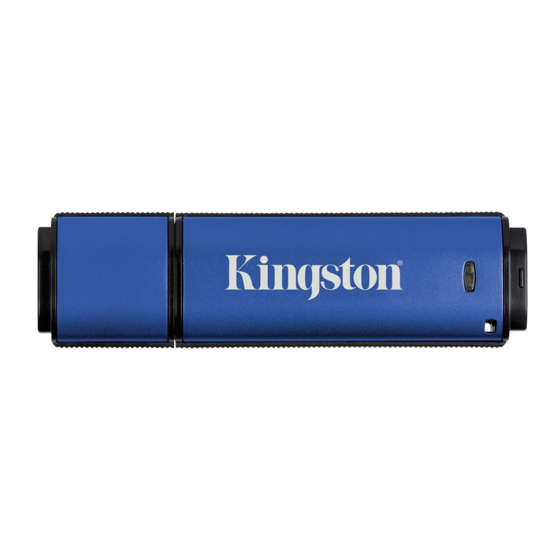Table of Contents
Advertisement
Quick Links
Help for DTVP-M Users
Introduction
Recommendations
Password Criteria
Introduction
This document covers the DataTraveler
M from this point forward) based on the default factory settings with no customizations.
The instructions and procedural steps in this help document were created based on the default 'out-of-
box' settings configured in the SafeConsole Management Server.
Policies implemented in SafeConsole are "pushed" out to the DTVP-M device during initialization and
reflect in the menu options available (or unavailable) in the client interface of the DTVP-M. To ensure
the desired user experience and proper deployment of the device, please consult your helpdesk and/or
SafeConsole administrator prior to use.
Recommendations
To ensure there is ample power provided to the DTVP-M device, use only in USB ports connected
directly to your notebook or desktop, as seen in Figure 1.1. Avoid connecting the DTVP-M to any
peripheral device(s) that may feature a USB port, such as a keyboard or USB hub, as in Figure 1.2.
Figure 1.1 – Recommended Usage
Document No. 48000031-001.A00
System Requirements
• Pentium III Processor or equivalent (or faster)
• 15MB free disk space
• USB 2.0
• Windows XP SP2/SP3, Vista SP1/SP2, & 7
• Two consecutive drive letters after the last physical
disk drive
®
Vault Privacy – Managed device (referred to simply as DTVP-
®
DataTraveler
Vault – Privacy Managed
Figure 1.2 – Not Recommended
help.pdf
[Back to top]
[Back to top]
Page 1 of 6
Advertisement
Table of Contents

Summary of Contents for Kingston Technology Vault Privacy-Managed
- Page 1 help.pdf Help for DTVP-M Users Introduction System Requirements Recommendations • Pentium III Processor or equivalent (or faster) Initialization • 15MB free disk space DTVP-M Login • USB 2.0 Password Criteria • Windows XP SP2/SP3, Vista SP1/SP2, & 7 Device Lockout •...
- Page 2 Initialization [Back to top] After plugging the DTVP-M device into a USB port, if you receive the following warning message, “Kingston DataTraveler requires active SafeConsole server to make it operational” (see Figure 1.3), please contact your helpdesk or SafeConsole Administrator. Figure 1.3 –...
- Page 3 Once a connection to the server is confirmed, you will be asked to create a password that will be used to unlock the secure data partition each time you log into the DTVP-M. 1. Once you’ve decided on a password, enter it into the ‘Select password’...
- Page 4 DTVP-M Login [Back to top] You must supply your DTVP-M password each time you wish to log into the device. During the login process, if an incorrect password is entered, you will be given another opportunity to enter the correct password;...
- Page 5 Forgot Password [Back to top] The ‘Remote Password Reset’ is a feature in SafeConsole that allows DTVP-M users to change/create passwords without resetting the device, thus saving all data stored on the DTVP-M. The ‘Forgot Password’ menu option is available on the DTVP-M ONLY when ‘Remote Password Reset’ is enabled on the SafeConsole Management Server (consult your helpdesk or administrator for details.) (Note: Remote Password Reset needs to be enabled on the SafeConsole Management Server PRIOR to initializing the DTVP-M device.
- Page 6 Drive Letter Conflict [Back to top] The DTVP-M requires two consecutive drive letters AFTER the last physical disk that appears before the ‘gap’ in drive letter assignments. This does NOT pertain to network shares because they are specific to user-profiles and not the system hardware profile itself, thus appearing available to the OS. What this means is, Windows may assign the DTVP-M a drive letter that’s already in use by a network share or Universal Naming Convention (UNC) path, causing a drive letter conflict.

















Need help?
Do you have a question about the Vault Privacy-Managed and is the answer not in the manual?
Questions and answers